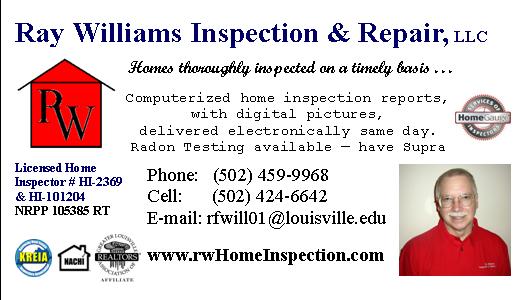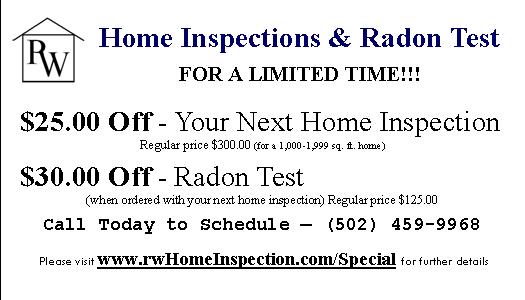Why Use Ray Williams Inspection & Repair, LLC
Radon -
What is it?
Is Radon harmful to me?
Why should I be interested in and test for Radon?
What is Mitigation?
The information below may help answer some of the questions you have about Radon when buying a house.
There are also some resources listed below that are available on the internet.
First of all, Radon is a cancer-causing, radioactive gas. You can't see it, you can't
smell it, nor taste it, but radon may be a problem in your home. Radon is estimated to cause
thousands of deaths each year. That's because when you breathe air containing radon, you can
get lung cancer. In fact, the Surgeon General has warned that radon is the second leading cause
of lung cancer in the United States today. Only smoking causes more lung cancer deaths. If you
smoke and your home has high radon levels, your risk of lung cancer is especially high.
What is Radon?
First of all, Radon is a gas that comes from the natural (radioactive) breakdown of uranium in soil,
rock, and water. The Radon gas gets into the air you breathe and can get into any type of building
and result in a high indoor radon level. You and your family are most likely to get your greatest
exposure at home, where you spend most of your time. Radon gas has been identified as a leading
cause of lung cancer, second only to cigarette smoking in the United States. If you smoke and your
home has high radon levels, your risk of lung cancer increases 3 times.
EPA's most recent health risk assessment estimates that 20,000 lung cancer deaths
occur each year are due to radon. You can't see or smell radon because it is a colorless, odorless gas.
The only way to know whether elevated levels of radon exists in your home is to TEST!
Smoking greatly increases your chances of lung cancer if elevated levels of radon exist.
If elevated radon levels are found (4 pCi/l or higher)
Average Rate 20 per 1,000
Smokers 60 per 1,000
Non Smokers 7 per 1,000
If elevated radon levels are found (4 pCi/l or higher)
How Does Radon Get Into Your Home?
Radon is a radioactive gas that moves up through the ground and into your home through cracks and
other holes in the foundation. Your home traps radon inside, where it can build up. Any home may
have a radon problem. This means new and old homes, well-sealed and drafty homes, and homes with or without basements (slabs).
Testing for Radon
Testing is the only way to know if you and your family are at risk from radon. EPA recommends testing
all homes in the lowest living area. Testing is inexpensive, easy, and it should only take 2 days
for the results. Millions of Americans have already tested their homes for radon.
The amount of radon in the air is measured in "Pico curies per liter of air," or "pCi/L."
There are many kinds of low-cost "do-it-yourself" radon test kits you can get through the
mail, in hardware stores, and other retail outlets . . . or, you can hire a qualified tester
who is certified to do the testing for you.
I am nationally certified to test for radon and use a Continuous Radon Monitor (CRM).
This provides continuous readings that are recorded hourly over a 48-hour period. I believe
this is the most accurate method of determining the true radon concentration level. The final
results are delivered electronically to the client and the realtor within hours of ending the test.
$30 off a radon test is currently being offered.
To see the details click on the link above - Current Special. My prices are competitive and with this discount make them an exceptional deal. Let me help you and your clients find the home they want without any surprises.
Radon and Home Sales
More and more home buyers are asking about radon levels before they buy a home. Buyers frequently
want tests made by someone who is not involved in the home sale and is a qualified tester. Because
real estate sales happen quickly, there is often little time to deal with radon and other issues.
The best thing to do is to test for radon NOW. If the radon levels are high, many buyers negotiate
with the seller to fix the problem.
What Your Test Results Mean?
The average indoor radon level is estimated to be about 1.3 pCi/L, and about 0.4 pCi/L of radon is normally
found in the outside air. The U.S. Congress has set a long-term goal that indoor radon levels be no more than
outdoor levels. While this goal is not yet technologically achievable in all cases, most homes today can be
reduced to 2 pCi/L or less.
If your living patterns change and you begin occupying a lower level of your home (such as a basement)
you should retest your home on that level. Even if your test result is below 4 pCi/L, you may want to
test again sometime in the future.
What if the Radon level is high?
You CAN fix a radon problem. Radon reduction systems (Mitigation) work and they are not too costly.
Some radon reduction systems can reduce radon levels in your home by up to 99%. Even very high levels
can be reduced to acceptable levels.
How to Lower the Radon Levels in Your Home (Mitigation)
THERE IS NO CAUSE FOR ALARM! Houses with elevated radon concentrations are EASILY and inexpensively
fixed (mitigated). Radon mitigation reduces concentrations by up to 99% & are accepted nationally
as home improvement. Very little maintenance & operating costs generally less than $10 per month.
Since there is no known safe level of radon, there can always be some risk. But the risk can be reduced
by lowering the radon level in your home. There are several proven methods to reduce radon in your home,
but the one primarily used is a vent pipe system and fan, which pulls radon from beneath the house and
vents it to the outside. This system, known as a soil suction radon reduction system, does not require
major changes to your home. Sealing foundation cracks and other openings makes this kind of system more
effective and cost-efficient. Similar systems can also be installed in houses with crawl spaces. Radon
contractors can use other methods that may also work in your home. The right system depends on the design
of your home and other factors.
The cost of reducing radon in your home depends on how your home was built and the extent of the radon problem.
Most homes can be fixed for about the same cost as other common home repairs. The cost to fix can vary widely,
but according to many realtors Ive spoken with in the Louisville Area, the average cost for installing a mitigation
system runs approximately $600-800. Check with your realtor and get one or more estimates from qualified mitigators.
Radon Myths
MYTH: Scientists are not sure that radon really is a problem.
FACT: Although some scientists dispute the precise number of deaths due to radon, all the major
health organizations (like the Centers for Disease Control and Prevention, the American Lung
Association and the American Medical Association) agree with estimates that radon causes
thousands of preventable lung cancer deaths every year. This is especially true among smokers,
since the risk to smokers is much greater than to non-smokers.
MYTH: Radon testing is difficult, time-consuming and expensive.
FACT: Radon testing is easy. You can test your home yourself or hire a qualified radon test
company. Either approach takes only a small amount of time and effort.
MYTH: Homes with radon problems can't be fixed.
FACT: There are simple solutions to radon problems in homes. Hundreds of thousands of
homeowners have already fixed radon problems in their homes. Most homes can be fixed for about
the same cost as other common home repairs; check with one or more qualified mitigators. Call
your state radon office for help in identifying qualified mitigation contractors.
MYTH: Radon affects only certain kinds of homes.
FACT: House construction can affect radon levels. However, radon can be a problem in homes of
all types: old homes, new homes, drafty homes, insulated homes, homes with basements, and homes
without basements. Local geology, construction materials, and how the home was built are among
the factors that can affect radon levels in homes.
MYTH: Radon is only a problem in certain parts of the country.
FACT: High radon levels have been found in every state. Radon problems do vary from area to
area, but the only way to know your radon level is to test.
MYTH: A neighbor's test result is a good indication of whether your home has a problem.
FACT: It's not. Radon levels can vary greatly from home to home. The only way to know if your
home has a radon problem is to test it.
MYTH: Everyone should test their water for radon.
FACT: Although radon gets into some homes through water, it is important to first test the air
in the home for radon. If your water comes from a public water supply that uses ground water,
call your water supplier. If high radon levels are found and the home has a private well, call
the Safe Drinking Water Hotline at 1 800-426-4791 for information on testing your water.
MYTH: It's difficult to sell homes where radon problems have been discovered.
FACT: Where radon problems have been fixed, home sales have not been blocked or frustrated. The
added protection is some times a good selling point.
MYTH: I've lived in my home for so long, it doesn't make sense to take action now.
FACT: You will reduce your risk of lung cancer when you reduce radon levels, even if you've
lived with a radon problem for a long time.
MYTH: Short-term tests can't be used for making a decision about whether to fix your home.
FACT: A short-term test, followed by a second short-term test* can be used to decide whether
to fix your home. However, the closer the average of your two short-term tests is to 4 pCi/L,
the less certain you can be about whether your year-round average is above or below that level.
Keep in mind that radon levels below 4 pCi/L still pose some risk. Radon levels can be reduced
in most homes to 2 pCi/L or below.
*If the radon test is part of a real estate transaction, the result of two short-term tests can
be used in deciding whether to mitigate. For more information, see EPA's "Home Buyer's and
Seller's Guide to Radon" by visiting www.epa.gov/radon/pubs/hmbyguid.html.
Here are some resources you may want to check out . . .
www.epa.gov/radon
www.epa.gov/radon/pubs/citguide.html
A Citizen's Guide to Radon
The Guide to Protecting Yourself and Your Family From Radon
Publications
Radon publications in print can be downloaded, most are in HTML and as PDF files. You can request
a print-quality version of this document, see www.epa.gov/radon/pubs
Most of the information above was shared from the EPA website:
www.epa.gov/radon/pubs/citguide.html#overview
A Citizen's Guide to Radon
The Guide to Protecting Yourself and Your Family From Radon
If you are looking to buy a home and have it professionally inspected or tested for radon, please give me a call at (502) 459-9968 (Bus Office) or my cell phone (502) 424-6642.
If you have any questions or would like additional information, please
send an email to the attention of Ray at:
Ray
This page was first written 10/13/2010 . . .
Thank you for visiting.
Please let me know if I may be of service.
Thank you.
Ray Williams
Ky Licensed Home Inspector
HI-2369
NEHA 105385 RT

